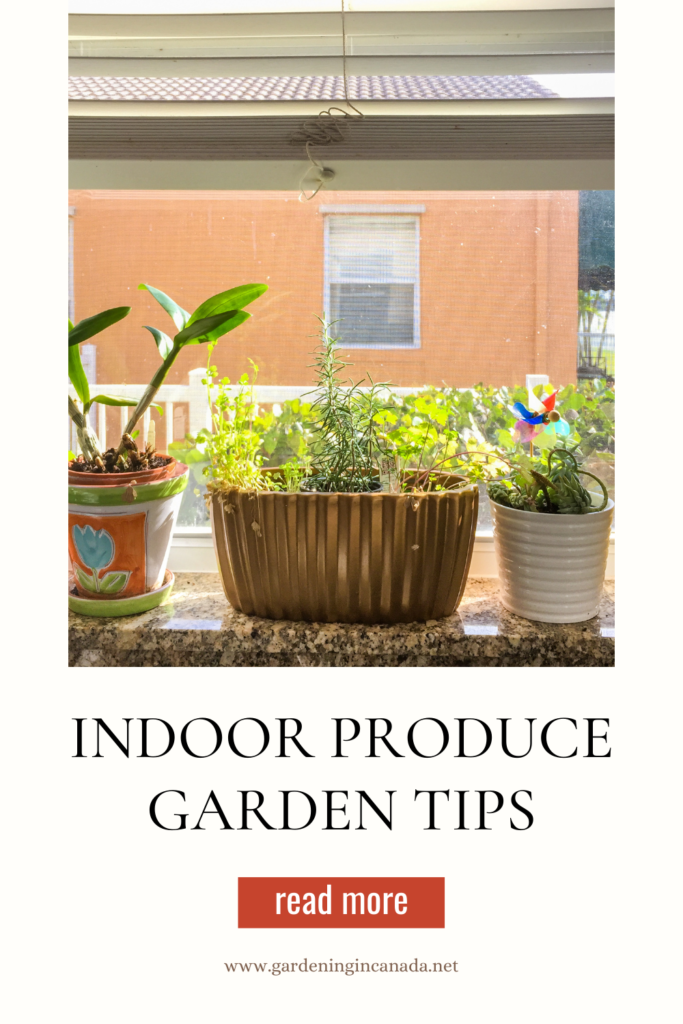- Canada’s Growing Zones Are Changing 2024 - January 12, 2024
- Attracting Wildlife To The Garden - May 16, 2023
- How To Garden Near A Septic Tank - May 9, 2023
Growing produce indoors can be a fun and rewarding activity, especially if you don’t have access to an outdoor garden. Here are some tips for growing produce indoors using potting soil:
- Choose the right container: Select a container that is large enough for the plant to grow and has proper drainage. Make sure to use a container with a drainage hole to prevent excess water from sitting in the soil and causing the roots to rot.
- Use high-quality potting soil: It’s important to use potting soil that is specifically formulated for indoor plants. Look for soil that is well-draining and has a balanced pH. Avoid using outdoor soil, as it may not have the necessary nutrients and can harbor pests and diseases.
- Choose the right plants: Some plants are better suited for indoor growth than others. Leafy greens, herbs, and tomatoes are good options for indoor gardens. Avoid plants that need a lot of space or light, as they may not thrive in a small indoor setting.
- Provide proper lighting: Most indoor plants need at least six hours of sunlight per day to thrive. If your space doesn’t get enough natural light, consider using grow lights to provide the necessary illumination.
- Water regularly: Water your plants when the soil feels dry to the touch. Avoid overwatering, as this can lead to root rot. Use a watering can or a watering bottle with a spout to gently water the soil and avoid disturbing the roots.
Container Choice For Indoor Gardening
When it comes to choosing a container the options are endless. Keep in mind you will want to choose between self-watering and something with drainage. To ensure I have less of a mess when it comes to watering I opt for a self-watering bucket.
I am using plastic in many cases so ensuring the plastic I am using is food safe is key. The food-safe plastics include 1,2, & 4. If you are using metal ensure it is stainless steel and rust-free. Other options can include cardboard, terracotta, or classic garden pots.
You want to talk into consideration the size of these pots and ensure they are big enough to bring the plant to full maturity. Below is a printable that goes through the proper sizes needed for each plant type. If you are using a self-watering container you can typically go with something smaller due to the access to water.
A good rule of thumb is for peppers, tomatoes, cucumbers, and larger herbs one – two plants per five-gallon pail will work. For lettuce, herbs, and root veggies go with 4 plants per 5 gallons of soil.
Choosing A Potting Soil For Indoor Gardening
- When choosing potting soil go for dehydrated or something that has been stored indoors. These two options will help ensure there are fewer pests that come along for the ride. Soil that has been stored outside will contain eggs and larvae of things such as gnats.
- If this is of concern leave the soil outside to freeze for a week before bringing it indoors. Otherwise use predatory nematodes to help eliminate any pest issues. To learn more about this check out this article.
- Ideally, the soil you choose will have slow-release fertilizer incorporated into the mixture. If not opt for a liquid fertilizer over a granular one to prevent burn and supply the plant with adequate nutrients.
- Lastly, consider getting potting soil with lots of pumice and perlite. If this is not in the mix buy it separately and incorporate it! This is important to avoid anaerobic soils and ultimately root rot in the pots.
Choosing the right plants for indoor gardening
The world is your oyster any plant will work in an indoor setup. One thing to keep in mind is that anything that flowers will need to be pollinated by yourself. This will involve Qtips or a gentle shake of the flowers. I have lots of videos on this topic over on youtube if you want to learn more.
Another thing to consider is that leafy lettuce tends to grow better than heads of lettuce in an indoor setup and allows for continual harvesting. Here is a great Canadian Vendor for Seeds!
Lighting For Gardening Indoors
Choosing the right grow light can make a big difference in the success of your indoor garden. Here are some things to consider when selecting a grow light:
- Light spectrum: Different plants have different light spectrum needs. For example, blue light is important for leafy greens, while red light is important for flowering plants. Look for a grow light that provides a full spectrum of light, or select a grow light that is specifically designed for the types of plants you are growing.
- Wattage: The wattage of a grow light determines how much light it produces. Higher-wattage grow lights are more powerful and may be necessary for larger plants or for plants that need a lot of light.
- Coverage area: Consider the size of your indoor garden and choose a grow light that will provide sufficient coverage for the plants you are growing.
- Duration: Most plants need at least six hours of light per day to thrive. Choose a grow light that can provide the necessary duration of light for your plants.
- Cost: Grow lights can vary in price, so consider your budget when selecting a grow light. Keep in mind that a higher-quality grow light may be more expensive upfront, but it may also be more energy-efficient and last longer, ultimately saving you money in the long run.
By following these tips, you can successfully grow a variety of produce indoors using potting soil. Happy gardening!

